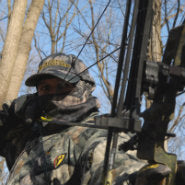 What can you do to boost your arrow's KE?For starters, you want to make sure you are maximizing the available KE by tuning your bow so your arrows fly straight. A fishtailing arrow won't fly as fast as it could. And make sure you're using razor-sharp broadheads. The more energy it takes to push an arrow through an animal, the faster it's going to slow down.You can shoot a heavier broadhead. That's going to slow down your arrow a bit, so you've got to repeat the KE calculation to make sure you're getting a benefit from the switch.You can switch to a heavier arrow shaft. It's also going to fly slower, so be sure you recalculate your KE.And make sure you don't change the arrow's spine when you switch to a heavier shaft.(Click here for a discussion about arrow spine vs. arrow weight.)Compound bow shooters can increase the draw weight of their bows by turning the limb bolts clockwise, provided they're not already at the maximum weight limit.Be sure to turn the top and bottom bolts exactly the same. That is, if you put half a turn into the top bolt, do the same to the bottom.Recurve archers who shoot takedown bows might want to switch to limbs with a heavier draw weight.Increasing draw weight increases arrow speed regardless of the bow.Of course, that can make your bow difficult - if not impossible - for you to draw, so proceed with caution.Know your KE before you hit the woods this season. It can mean the difference between success and failure.
What can you do to boost your arrow's KE?For starters, you want to make sure you are maximizing the available KE by tuning your bow so your arrows fly straight. A fishtailing arrow won't fly as fast as it could. And make sure you're using razor-sharp broadheads. The more energy it takes to push an arrow through an animal, the faster it's going to slow down.You can shoot a heavier broadhead. That's going to slow down your arrow a bit, so you've got to repeat the KE calculation to make sure you're getting a benefit from the switch.You can switch to a heavier arrow shaft. It's also going to fly slower, so be sure you recalculate your KE.And make sure you don't change the arrow's spine when you switch to a heavier shaft.(Click here for a discussion about arrow spine vs. arrow weight.)Compound bow shooters can increase the draw weight of their bows by turning the limb bolts clockwise, provided they're not already at the maximum weight limit.Be sure to turn the top and bottom bolts exactly the same. That is, if you put half a turn into the top bolt, do the same to the bottom.Recurve archers who shoot takedown bows might want to switch to limbs with a heavier draw weight.Increasing draw weight increases arrow speed regardless of the bow.Of course, that can make your bow difficult - if not impossible - for you to draw, so proceed with caution.Know your KE before you hit the woods this season. It can mean the difference between success and failure.
Published September 16, 2015 in Archer's DictionaryBy P.J. Reilly
What is Kinetic Energy and Why does it matter?

 What can you do to boost your arrow's KE?For starters, you want to make sure you are maximizing the available KE by tuning your bow so your arrows fly straight. A fishtailing arrow won't fly as fast as it could. And make sure you're using razor-sharp broadheads. The more energy it takes to push an arrow through an animal, the faster it's going to slow down.You can shoot a heavier broadhead. That's going to slow down your arrow a bit, so you've got to repeat the KE calculation to make sure you're getting a benefit from the switch.You can switch to a heavier arrow shaft. It's also going to fly slower, so be sure you recalculate your KE.And make sure you don't change the arrow's spine when you switch to a heavier shaft.(Click here for a discussion about arrow spine vs. arrow weight.)Compound bow shooters can increase the draw weight of their bows by turning the limb bolts clockwise, provided they're not already at the maximum weight limit.Be sure to turn the top and bottom bolts exactly the same. That is, if you put half a turn into the top bolt, do the same to the bottom.Recurve archers who shoot takedown bows might want to switch to limbs with a heavier draw weight.Increasing draw weight increases arrow speed regardless of the bow.Of course, that can make your bow difficult - if not impossible - for you to draw, so proceed with caution.Know your KE before you hit the woods this season. It can mean the difference between success and failure.
What can you do to boost your arrow's KE?For starters, you want to make sure you are maximizing the available KE by tuning your bow so your arrows fly straight. A fishtailing arrow won't fly as fast as it could. And make sure you're using razor-sharp broadheads. The more energy it takes to push an arrow through an animal, the faster it's going to slow down.You can shoot a heavier broadhead. That's going to slow down your arrow a bit, so you've got to repeat the KE calculation to make sure you're getting a benefit from the switch.You can switch to a heavier arrow shaft. It's also going to fly slower, so be sure you recalculate your KE.And make sure you don't change the arrow's spine when you switch to a heavier shaft.(Click here for a discussion about arrow spine vs. arrow weight.)Compound bow shooters can increase the draw weight of their bows by turning the limb bolts clockwise, provided they're not already at the maximum weight limit.Be sure to turn the top and bottom bolts exactly the same. That is, if you put half a turn into the top bolt, do the same to the bottom.Recurve archers who shoot takedown bows might want to switch to limbs with a heavier draw weight.Increasing draw weight increases arrow speed regardless of the bow.Of course, that can make your bow difficult - if not impossible - for you to draw, so proceed with caution.Know your KE before you hit the woods this season. It can mean the difference between success and failure.

